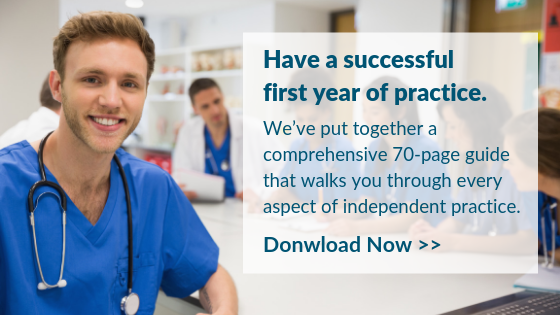What is an EMR?
Electronic Medical Records (EMRs) are software programs that are digital versions of the traditional paper-based medical records, that are normally found in a paper chart. They store your patient’s medical history, medications, immunization dates, doctors notes, etc. They are amazing platforms that really help centralize patient records, and in this day and age, they are essential in any modern day practice.
Using an EMR system is one of the best ways to streamline your daily tasks and keep track of patient care. Depending on where you’re working, let’s say at a hospital or outpatient care, most likely there’s already an EMR system in place. If you’re starting your own practice though, you’ll need to decide which one to implement.
In this article we outline:
How to Learn EMR Systems
More often than not, if you’re working in a hospital or doing locum work, you won’t be able to choose the exact EMR system you’re going to use. So, exactly how to learn EMR systems? The best way is to get familiar with what general features EMR systems have (for example, our list below) and then always try to ask what system is being used before your first day. Trying to find out a bit more about the system before you use it is a great example of how to best use EMR systems.
Some Good questions to ask beforehand:
- What EMR is used?
- Who is the “go-to” person for questions about the EMR in the clinic / in the community?
- Is there a user-group for the EMR in the community?
- Are there built-in forms in the EMR? If so, which ones?
- Are there templates/macros? (for physicals etc.).
How to Use EMR Systems
Once you know what EMR you’re going to be using make sure you:
- Set-up your login credentials.
- Walk through the EMR yourself and identify which areas you’ll likely use on a daily basis (you won’t need to learn every feature of an EMR).
- Follow along with a free demo/tutorial
(usually offered on the companies direct website or by typing in the company’s name on YouTube).
If you are already familiar with the system and features, then go deeper into how to use EMR systems by identifying which features it has that can help you be more productive. For example, a lot of the doctors we’ve surveyed said setting up your own EMR templates are a great way to stay more organized and make your workflow more productive by grouping together day to day medical conditions or common scenarios.
7 Key Features you want to make sure your EMR System has
Whether you’re looking for a new EMR system to set up or you just want to know what popular features you can expect from an EMR solution, first make sure you understand what the company offers in terms of security and privacy. While these two features are basic, they are extremely important when it comes to any system that handles patient data.
Second, make sure they have a webinar or on-line training that will help you get used to using it. Generally, EMR systems are not always easy to navigate so having help right away will ease the learning curve.
Besides security, privacy, and support, the right electronic medical record system should be saving you time while helping you improve patient care. Below is a look at the top 7 key features that every EMR system must have.
1. Customizable EMR Templates
One of the best features in electronic medical record systems is the ability to create templates. Expect a good EMR to have easy-to-use templates where you can fill in the information quickly.
Templates will speed up the charting process so that you get it done in only a few taps, while also creating easy to view patient data for quick referencing.
You should also make sure you have the ability to create your own templates – as no two practices are exactly the same. That way, you can save your own frequently used information so that when you see patients with similar diagnoses you can speed up the entire workflow process.
Here’s an example of the various templates you could create on your EMR system:
- Day to day medical conditions/common patient encounters
- Intakes and response letters
- Quick-links to frequently used medications and diagnostic codes
- New Consult Assessments
- Other examples; newborn-4 yo checks, paps, IUD insertions.
You should never use an EMR that doesn’t have charting and customizable EMR templates.
TIP: If you work as a locum, or in more than one place, and find yourself working with several EMR systems, try creating your own templates and storing them in evernote so that you can easily copy and paste them whenever you need.
2. Reporting & 24/7 Access
You’ll want to make sure the electronic medical record system is available 24/7 from anywhere – this means it’s built on a web-based platform (cloud hosting) so that you can access it on any device (web, mobile or tablet) from anywhere you have an internet connection. This means you’ll get access to your patients records whether you’re in the clinic, at the hospital or on the go!
The best electronic medical records will let you set up customizable reports and let you generate them on a regular basis that works for you (weekly, monthly, quartley, etc.). Reports should be generated automatically based on all the information that your EMR collects, like patient history, documents, test results, financial data, and overall just any information that gets recorded.
For example, if you’re working in a lab-dependent practice then your EMR system should electronically monitor the delivery, analysis, results, and certainty of any lab tests and provide charts and downloadable reports.
It’s best to make sure you ask your potential EMR solution how exactly their reporting system works and how you can best customize it to suit your practice.
3. Provider-to-provider Communications
Along with being able to access EMR systems from anywhere, you should also be able to share information between physicians. Being able to quickly receive or send patient records to someone else, say a referring physician, helps speed up your patient’s treatment time by making sure that every physician has an updated and accurate account of the patient’s history.
Aside from sending patient information, your EMR should have a centralized communication system so you can chat directly with another doctor or leave them messages. This centralizes patient-related communication and makes it easier to record and view up-to-date patient data.
4. Scheduling Features
Scheduling should be done inside EMR systems so that you can easily keep track of appointments. But what’s the difference between having scheduling features within your electronic medical record software system versus. just having an electronic appointment software?
Well, if your scheduling system is kept inside your EMR then anytime you schedule an appointment or a follow-up or reminder, you’ll have the ability to notify your patients immediately. This really helps save time in the office (for example, no one will need to make a reminder call), as well decrease the amount of missed appointments.
Having a scheduling feature is a very powerful tool since you can usually customize it to meet a specific need. For example, scheduling reminders for test results.
Overall scheduling features should improve your productivity by centralizing a lot of your admin processes and organizing your calendar and notification system.
5. E-Prescriptions
The ability to quickly send prescriptions and authorize refills is a great feature to look for in EMR systems. This feature will not only make it easier for your patients to get their medications (no more poorly written prescriptions), but you’ll be able to communicate directly with pharmacies. For example, you can forward the prescription directly to your patients preferred pharmacy.
Besides two-way communication with pharmacies, your EMR should also track medications that have been prescribed to your patients and have the ability to notify you if any of their medications might interact with other medications they’re taking, or with any allergies they may have.
This helps make sure you’re always prescribing safely. A great additional feature to this is when an interaction or potential harmful effect is detected then an alternative solution is suggested.
6. Patient Portals
Patient portals are a great way to help educate patients and give them a platform to exchange information with their doctors and speed up their recovery time. Good electronic medical record systems will provide a secure login for patients where they can easily access:
- Educational materials (like care-instructions).
- Forms to sign or download.
- Lab results.
- Information from their last visit.
- A list of their allergies, immunizations, and medications.
- Recent doctor visits & discharge summaries.
- Appointment scheduling.
- Prescription refill request.
- Contact Information.
Patient portals are a great way to encourage patients to book appointments online, which reduces phone calls and admin tasks. Additionally, it gives them a centralized place where all their medical health information is kept and updated. Some EMR systems let you customize the portal so you can share newsletters, preventative care recalls and targeted health promotions.
7. Lab Integration
If you want to use your EMR to streamline your practice and boost your efficiency then you need to make sure it integrates well with a laboratory, whether the lab is on or off site.
This will make it easy to monitor the delivery of test samples and track results. The results will automatically be added into the patient’s chart, which saves you time by not having to manually enter each lab/image result. If your patients results come back and are abnormal in any way then it’s typical that you’d be notified immediately on the EMR screen, or some type of banner would pop up alerting you.
If you’ve chosen an EMR that also has a patient portal then your patient will also be able to access their lab results as soon as they’re ready.
A good lab integration will not only make communication between you and lab easier, it should display the results in an easy-to-read format so that they are easy to understand for both you and your patient.
What’s the #1 EMR Feature?
While everything mentioned above helps improve efficiency, the number 1 feature to look for when choosing any EMR system is flexibility.
The ability to customize your EMR system and make it work for you however you want to use it, whether in a clinic or office setting, is extremely valuable. Being able to adjust templates, dashboards and report functionalities so that they make sense to you will help make the EMR system easier to use on a daily basis.
Popular EMR Systems in Canada
If you’ve landed here looking for specific solutions to check out, here’s a list of popular EMR systems used across Canada:
TELUS EMR SOLUTION
Telus offers many ≈ for many Canadian physicians as they have a variety of digital healthcare tools. Their EMR solutions focus on optimizing your practice and facilitating continuity of care. If you’re looking for variety, it’s worth the time to check out their different options.
For example, there’s Med Access EMR, a web-based EMR that adapts to your clinic, user and workflow needs, as well as Wolf EMR (a popular option) which is a cloud-based EMR that can be customized. They also have PS Suite EMR that was developed by physicians for physicians.
INPUTHEALTH
As the leading patient engagement platform, InputHealth streamlines workflows so you can focus on what matters most: your patients and their outcomes.
Their platform includes modules for patient booking, documentation, virtual care, questionnaires and more. InputHealth also leverages Dr.Bill’s platform to offer pain-free medical billing to the physicians that use their system.
CHS: Canadian Health System
CHS is another popular EMR system that claims it can decrease your charting time by 20% and office overhead by 15-25%. Like many EMR systems you can use it on a desktop, tablet or on your smartphone. An interesting feature they offer is the ability to take photos and add them directly into your notes.
MOIS EMR
MOIS EMR is a robust and standards-based EMR system designed to improve overall patient care and enhance provider efficiency. Look into this EMR solution if you’re really looking to customize something specific for your practice.
ARYA EHR
Arya was designed by doctors, for doctors. Arya gets to the heart of the work flows that physicians face everyday. It eliminates tedious steps, clicks and fields that slow down work speed. It has a clean interface that works on multiple devices and is cloud based so it can be accessed from home, office or hospital.
Arya Ehr isn’t just a solution for Medical Clinics (EMRs), it’s also a solution for various other health related facilities such as Assisted Living Homes to Physiotherapy Offices. Arya connects directly with Dr.Bill’s platform so you can also integrate your billing into the EMR system.
Oscar Pro is the 3rd largest EMR system in Canada and streamlines your clinic workflow, plugging you into a larger digital health system and giving you easy access to proven clinical tools. The pro version offers more support and features otherwise it’s similar to the original.
IntraHealth PROFILE EMR
Another popular EMR system is Profile, an integrated practice management and EMR package designed for operation by clinicians, practitioners, and administrative staff. It’s designed to be used on Windows and has mobile device compatibility for booking or cancelling appointments, checking test results, and communications between you and your patient.
CERNER
Cerner’s EMR system is made for teams, making it easy to share across different care teams and venues. Teams can document and access critical patient data and streamline workflows. They offer a variety of integrations to help keep your clinical, financial and operational data all working together.
ALLSCRIPTS SUNRISE
Lastly, Allscripts is a Popular EMR System recognized for easy implementation and ongoing support. Consider this solution if you’re looking for top notch clinical insight. They offer different solutions based on the type of care your practice offers and allow you to tweak/modify the system as you go, depending on the feedback you get from your team.
Conclusion
As technology advances electronic medical record systems are getting better and better as more features are being catered to doctors individual needs. Having all this technology helps speed up admin processes, improve patient-care and overall save you time.
Make sure you look for an EMR that includes all 7 features above, along with privacy, security and ease-of-use.
This article offers general information only and is not intended as legal, financial or other professional advice. A professional advisor should be consulted regarding your specific situation. While information presented is believed to be factual and current, its accuracy is not guaranteed and it should not be regarded as a complete analysis of the subjects discussed. All expressions of opinion reflect the judgment of the author(s) as of the date of publication and are subject to change. No endorsement of any third parties or their advice, opinions, information, products or services is expressly given or implied by RBC Ventures Inc. or its affiliates.

Claim Your $150 Credit!
Get a $150 Credit when you sign up for Dr.Bill*. No credit card required.
*Terms and conditions apply.





